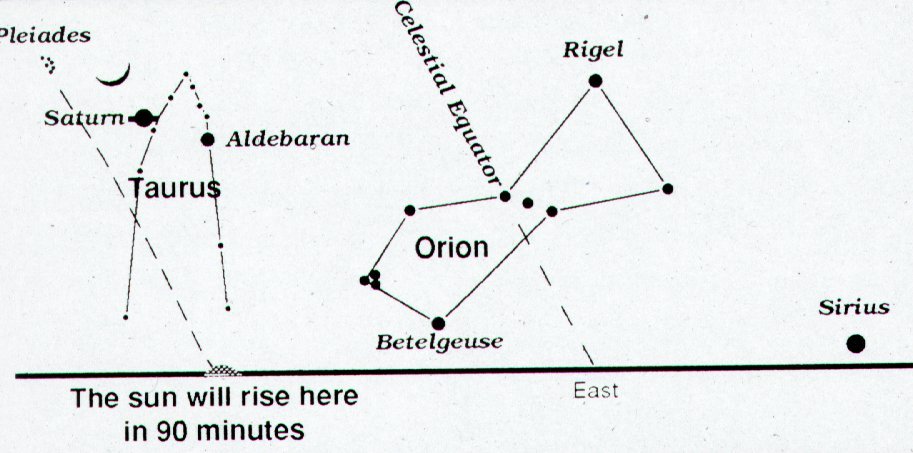2. The Tahitian star pillars (ana) has Betelgeuze (also spelled Betelgeuse) as number 8 (varu):
Sun will reach Ana-varu after Ana-muri (Aldebaran), i.e. beyond 'the stern of the ship of Sun', accompanied by many bright stars:
He will come to the Pleiades first, an ancient sign for the beginning of a new year. We can see in the picture that Ana-muri (Aldebaran) - 'the stern of summer' - is beyond the Pleiades and when the 6 stars of Tauono are rising it should not, therefore, signify the birth of a new year. And the Gilbertese instead used the setting of the constellation as a sign. Possibly the Polynesians used number 6 (instead of 7) in order to call attention to the fact that Tauono belonged in late autumn. Sirius (another ancient sign for the beginning of a new year) is beyond Ana-varu. Thus the 8th star pillar will rise close to winter solstice. ... The rising Pleiades led a twinkling procession of bright stars into the sky: Aldebaran first, then the stars of Orion (called Tautoru by the Rapa Nui). Sirius (Reitanga in Rapanui), at a declination of 16º 42', is the brightest star in the sky on this and every other morning, and travels a path that takes it over the centre of Polynesian culture, Tahiti ... The beginning of a new year is where Sun has his lowest position, at winter solstice. The end of the previous year should come earlier, but not very much so. I have earlier (cfr at Rau Hei) guessed Sirius has the position of vaha mea (the red opening) in Ga1-4:
From this and from the present position of Sirius, 4 days after winter solstice (south of the equator), we can count which glyph should correspond to Betelgeuze:
The right ascension of Betelgeuze is 05h 52m = 5 * 60 + 52 = 352 minutes, which should be compared to 24 * 60 = 1440 for the whole circle. The position of Ana-varu is 352 / 1440 * 365 = 89 days counted from vernal equinox north of the equator, which means day number 266 + 89 = 355 on Easter Island, a number which happens to agree with 71 * 5 at Ga7-15:
The 'berries' in front can hardly represent Tautoru (the 3 belt stars of Orion), and their number agrees better with Tauono (the Pleiades, the 6 'stones'). The empty-handed person is not looking at us but looking ahead, he has not come to a standstill. Maybe Ga7-15 refers to how the Pleiades will be rising together with Sun about half a year later. Counted from vaha mea in Ga1-4 the front side of the year is in the past:
The shark (mago) in Ga7-16 has a curved tail, which sign probably means 'close to the end'. Counted from Rogo in Gb6-26 it is glyph number 250. The curved tail in Ga7-16 could refer to the tail of Scorpio (with Antares). But to make it fit we have to imagine Aldebaran at Ga1-4. And then we can interpret the appearance of Ana-muri at the beginning and Ana-mua at the end of the front side as due to looking for them in the night - because Sun will then be at the 'antipodal' position in the sky. When in the night Aldebaran is in zenith, then Sun will be close to Ana-mua (the beginning of summer), and when Antares is in zenith, then Ana-muri (the end of summer) will be harbouring Sun. |
|||||||||||||||||||||||||||||||||||||||||||||||||||||||||||||||||||||||||||||||||||||||||||||||||||||||||||||||||||||||||||





